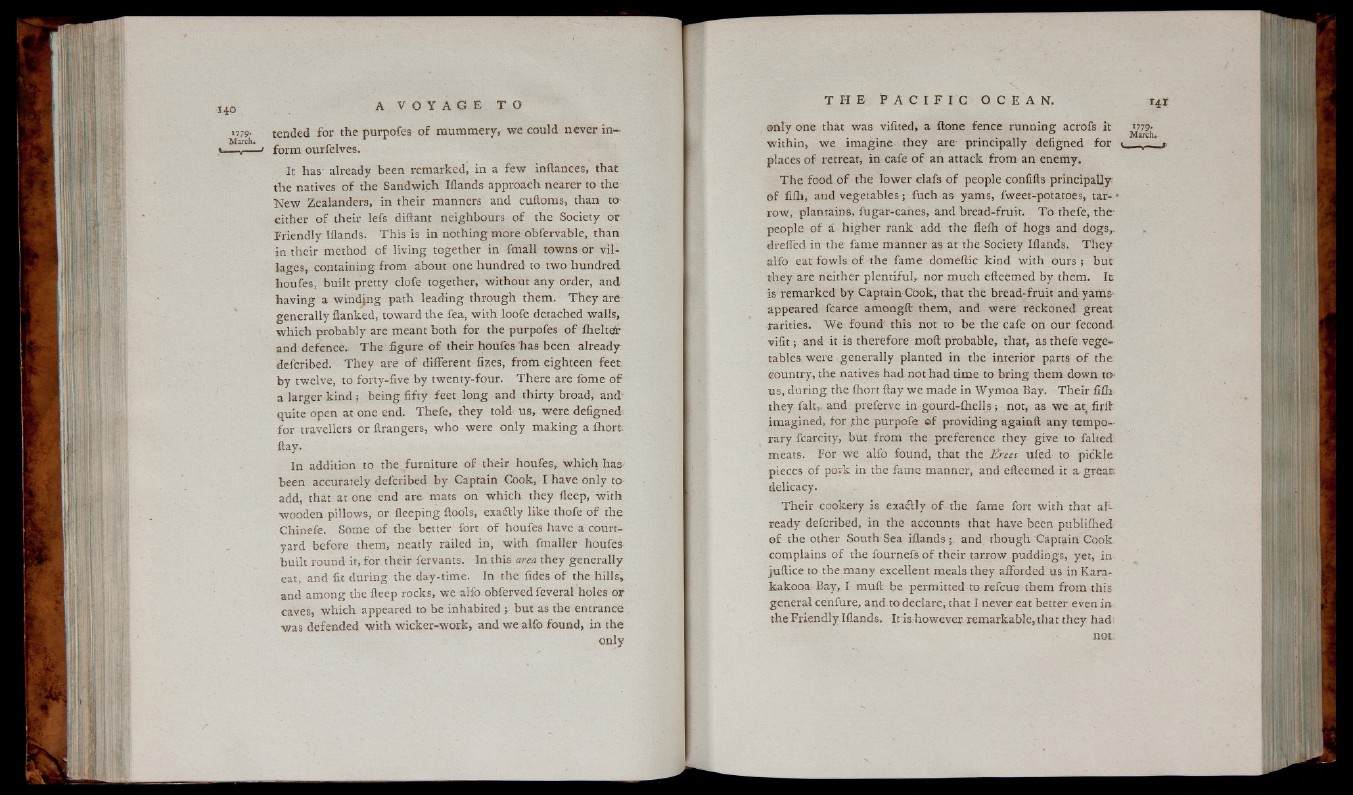
tended for the purpofes o f mummery, we could n ev e r in fo
rm ourfelves.
It has' already been remarked, in a few inftances, that
the natives o f the Sandwich Iflands approach nearer to the
New Zealanders, in their manners and cuiloms, than to
either o f their lefs diftan.t neighbours o f the Society or
Friendly Iilands. This is in nothing more obfervable, than
in their method o f living together in fmall towns or v illages,
containing from about one hundred to two hundred
houfes, built pretty clofe together, without any order, and
having a windjng path leading through them. They are
generally flanked, toward the fea, with loofe detached walls,
which probably are meant both for the purpofes o f iheltefc
and defence. The figure o f their houfes ’has been already
defcribed. They are o f different fizes, from eighteen fe e t
by twelve, to forty-five by twenty-four. There are fome o f
a larger kind ; being fifty feet long and thirty broad, and
quite open at one end. Thefe, they told us, were defigned
for travellers or ftrangers, who were only making a ihort:
flay.
In addition to the furniture o f their houfes, which has-
been accurately defcribed by Captain Cook, I have only to-
add, that at one end are mats on which they fleep, with
wooden pillows, or fleeping ftools, exa&ly like thofe o f the
Chinefe. Some o f the better fort o f houfes have a courtyard
before them, neatly railed in, with fmaller houfes
built round it, for their fervants. In this area they generally
eat, and fit during the day-time. In the fides o f the hills*
and among the fleep rocks, we alfo obferved feveral holes or
caves, which appeared to be inhabited j but as the entrance
was defended with wicker-work, and we alfo found, in the
only
on ly one that was vifited, a ftone fence ru nn in g acrofs it r779-
March.
within* w e ima gin e the y are principally defigned fo r c _
places o f retreat, in cafe o f an a ttack from an enemy.
The food o f the lower clafs o f people confifts principally
o f fiih, and vegetables; fuch as yams, fweet-potatoes, tar- •
row, plantains, fugar-canes, and bread-fruit. T o thefe, the'
people o f a higher rank add the fleih o f hogs and dogs,,
dreffed in the fame manner as at the Society Iflands. They
alfo eat fowls o f the fame domeftic kind with o u r s ; but
they are neither plentiful,, nor much efteemed by them. Iu
is remarked by Captain Cook, that the bread-fruit and; yams
appeared fcarce amongft them, and were reckoned great
rarities. We found1 this not to be the cafe on our fecond
v ifit; and it is therefore mod probable, that, as thefe vegetables
were generally planted in the interior parts o f the
country, the natives had not had time to bring them down to>
us, during, the ihort flay we made in Wymoa Bay. Their fiih
they fait,, and preferve in gourd-fhells; not, as we at firft
imagined, for .the purpofe e f providing againft any temporary
fcarcity, but from the preference they give to faltcd
meats. For we alfo found, that the Erees ufed to pickle
pieces o f pork in the fame manner, and efteemed it a great;
delicacy.
Their cookery is exactly o f the fame fort with that already
defcribed, in the accounts that have been publiihed
©f the other South Sea i i l ands and though Captain Cook
complains o f the fournefs o f their tarrow puddings, yet, in
juftice to the many excellent meals they afforded us in Kara-
kakooa Bay, I mult be permitted to refcue them from this-
general cenfure, and to declare, that I never eat better even in
the Friendly Iilands. It is however remarkable, that they had;
hot;